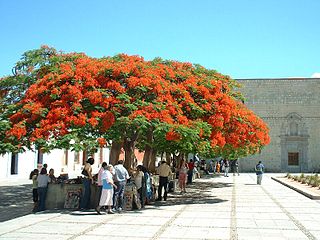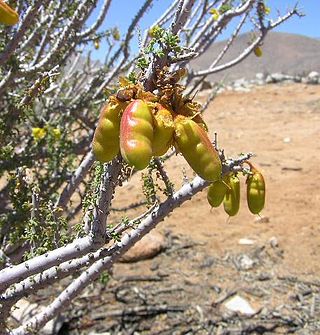
The Fabaceae or Leguminosae, commonly known as the legume, pea, or bean family, are a large and agriculturally important family of flowering plants. It includes trees, shrubs, and perennial or annual herbaceous plants, which are easily recognized by their fruit (legume) and their compound, stipulate leaves. The family is widely distributed, and is the third-largest land plant family in number of species, behind only the Orchidaceae and Asteraceae, with about 765 genera and nearly 20,000 known species.

Caesalpinioideae is a botanical name at the rank of subfamily, placed in the large family Fabaceae or Leguminosae. Its name is formed from the generic name Caesalpinia. It is known also as the peacock flower subfamily. The Caesalpinioideae are mainly trees distributed in the moist tropics, but include such temperate species as the honeylocust and Kentucky coffeetree. It has the following clade-based definition:
The most inclusive crown clade containing Arcoa gonavensisUrb. and Mimosa pudicaL., but not Bobgunnia fistuloides(Harms) J. H. Kirkbr. & Wiersema, Duparquetia orchidaceaBaill., or Poeppigia proceraC.Presl

Delonix is a genus of flowering plants in the family Fabaceae, subfamily Caesalpinioideae. It contains trees that are native to Madagascar and East Africa. By far the best known species is the Royal Poinciana.
Stuhlmannia moavi is a species of flowering plants in the legume family, Fabaceae. It is the only species in the genus Stuhlmannia. It is a tree native to Kenya, Tanzania, and Madagascar, where it grows in seasonally-dry tropical forest, woodland on limestone, and in riverine forest. The genus belongs to tribe Caesalpinieae in subfamily Caesalpinioideae.

Haematoxylum is a genus of flowering plants in the legume family, Fabaceae, subfamily Caesalpinioideae and the tribe Caesalpinieae. It includes five species, four of which are native to the tropical Americas from Mexico to Colombia, and one to Namibia.

Balsamocarpon brevifolium, or algarrobilla, is a species of flowering plants in the legume family, Fabaceae. It is the sole species in genus Balsamocarpon. Balsamocarpon belongs to the subfamily Caesalpinioideae and tribe Caesalpinieae. It is endemic to northern and north-central Chile.
Lophocarpinia aculeatifolia is a species of flowering plants in the legume family, Fabaceae. It is the sole species in genus Lophocarpinia. It is a tree native to Paraguay and northern Argentina. It belongs to tribe Caesalpinieae of subfamily Caesalpinioideae.
Pomaria is a genus of flowering plants in the legume family, Fabaceae. It includes 16 species of shrubs and perennial herbs native to North America, South America, and southern Africa. Typical habitats include drier subtropical grasslands and wooded grasslands, often on limestone, and degraded areas. It belongs to tribe Caesalpinieae of subfamily Caesalpinioideae.

The genus, Pterolobium, consists of 10 species of perennial flowering plants in the family Fabaceae, subfamily Caesalpinioideae and tribe Caesalpinieae. They are sometimes called redwings and are native to the tropical to subtropical climes of Africa and Asia, including Indonesia and the Philippines. They are large scrambling or climbing shrubs that grow in riverside thickets, on rocky slopes or at forest margins. They bear colourful samara fruit, and have pairs of thorns below the rachis of their bipinnate leaves.
Stenodrepanum bergii is a species of flowering plants in the legume family, Fabaceae. It is a perennial subshrub native to northern Argentina. It is the sole member of genus Stenodrepanum. It belongs to tribe Caesalpinieae in subfamily Caesalpinioideae.

Zuccagnia punctata is a species of flowering plant in the family Fabaceae. It is the sole species in genus Zuccagnia. It belongs to tribe Caesalpinieae of subfamily Caesalpinioideae.

The tribe Caesalpinieae is one of the subdivisions of the plant family Fabaceae: subfamily Caesalpinioideae.

Guilandina is a genus of flowering plants in the legume family, Fabaceae. It belongs to the subfamily Caesalpinioideae and tribe Caesalpinieae.

Mezoneuron is a genus of flowering plants in the legume family, Fabaceae. It belongs to the subfamily Caesalpinioideae and the tribe Caesalpinieae.

Tara is a genus of flowering plants in the legume family, Fabaceae. It includes three species of trees and shrubs native to the tropical Americas, from northern Mexico through Central America, the Caribbean, and western South America to Bolivia and Central Chile. Typical habitats include seasonally-dry tropical forest and semi-arid thorn scrub. It belongs to tribe Caesalpinieae of subfamily Caesalpinioideae.
Biancaea is a genus of flowering plants in the family Fabaceae. It includes seven species, which range from Yemen to south Asia, Indochina, Malesia, China, Korea, and Japan. It belongs to the subfamily Caesalpinioideae and the tribe Caesalpinieae.
Mezoneuron andamanicum is a species of 'cat's claw' lianas, previously placed in the genus Caesalpinia, in the tribe Caesalpinieae. This species is recorded from the Andaman Islands, Indo-China and Malesia, with no subspecies.
Mezoneuron pubescens is a species of 'cat's claw' lianas, previously placed in the genus Caesalpinia, in the tribe Caesalpinieae. This species is recorded from Malesia and Indo-China. with no subspecies.
Mezoneuron hymenocarpum is a species of 'cat's claw' lianas, previously placed in the genus Caesalpinia, in the tribe Caesalpinieae. Records are from: India, Indo-China, Malesia through to Australia, with no subspecies.
Gwilym Peter Lewis is a British botanist, a curator at the Royal Botanic Gardens, Kew, and a leading expert on neotropical Leguminosae.

















